What is network topology Types ?

What if the structure of your network could dictate its efficiency and resilience? Understanding network topology types is the key to unlocking your network’s true potential. Each topology offers distinct advantages and challenges, shaping how data flows and devices communicate. Whether it’s the robustness of a mesh or the simplicity of a star, selecting the right design is crucial for optimal performance and scalability. Discover the nuances of each configuration and elevate your network architecture to new heights. Dive into the world of network topology types and transform your connectivity today!
Table of Contents
What is Network Topology? Definition
Network topology types describe the geometric arrangement of various elements within a network, dictating how devices interconnect and communicate. This concept encompasses both physical layout the tangible arrangement of cables and hardware and logical topology, which focuses on how data flows between nodes. Understanding these network topology types is crucial for optimizing performance and reliability.
Each topology offers distinct advantages and drawbacks, influencing factors such as scalability, fault tolerance, and overall efficiency. For instance, a star topology provides centralized management and easy troubleshooting, while a mesh topology offers superior redundancy through multiple connections. Additionally, bus and ring topologies present unique solutions tailored to specific operational needs. By analyzing the characteristics of different network topology types, organizations can make informed decisions that enhance connectivity and ensure seamless data transmission. Ultimately, mastering these topologies is essential for creating robust, efficient networks capable of meeting today’s demands.
What are the Components of Network Topologies?
| Component | Description |
| Nodes | Individual devices within the network, such as computers, servers, printers, and routers. Each node acts as an endpoint for data transmission, facilitating both sending and receiving of information. Their performance and configuration directly influence the overall efficiency of the network. |
| Links | Physical or logical connections between nodes, which can be wired (e.g., Ethernet cables, fiber optics) or wireless (e.g., Wi-Fi signals). Links are critical for enabling communication, as they define the pathways along which data travels between devices. The choice of link type affects bandwidth, speed, and latency. |
| Network Devices | Equipment such as routers, switches, hubs, and bridges that manage and direct data traffic within the network. Routers connect different networks, while switches connect multiple devices within the same network, optimizing data flow and enhancing overall performance. |
| Communication Protocols | Rules and standards governing how data is transmitted across the network. Protocols like TCP/IP dictate how devices communicate and ensure data integrity during transmission. Understanding these protocols is vital for troubleshooting and optimizing network performance. |
| Topology Layout | The specific arrangement of nodes and links in the network, which can include various configurations such as star, bus, ring, and mesh. Each layout influences factors such as redundancy, scalability, and ease of management, impacting how effectively the network can respond to failures or growth. |
| Cabling | The physical medium used for wired connections, including types like coaxial, twisted pair, and fiber optic cables. The choice of cabling affects the network’s speed, distance, and susceptibility to interference, making it a critical aspect of network design. |
| Power Supply | The reliable source of power needed for network devices, ensuring they remain operational. This may include uninterruptible power supplies (UPS) to protect against outages and fluctuations, which is essential for maintaining network uptime and performance. |
Choosing the right network topology types is essential for optimizing performance and ensuring the reliability of your network infrastructure.
What are the Types of Network Topologies?
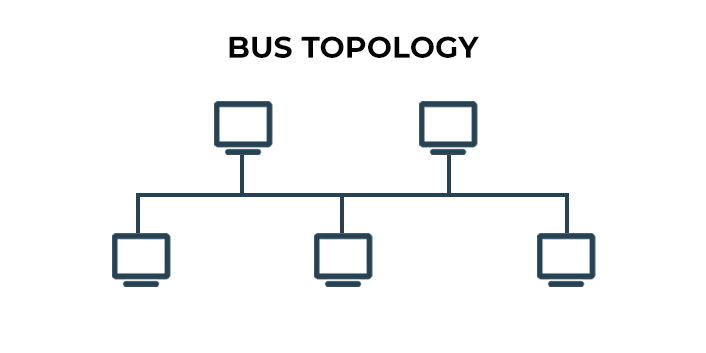
1- Bus Topology
Definition: Bus topology is a network configuration where all devices (nodes) are connected to a single central cable, known as the bus or backbone. Data transmitted by any device travels along this cable in both directions until it reaches its intended destination.
Characteristics
- Single Cable: All nodes are connected to a single communication line, which reduces the amount of cabling required compared to other topologies.
- Data Flow: Data travels in both directions along the bus, allowing all devices to communicate effectively.
Advantages
- Cost-Effective: Bus topology is less expensive to implement because it requires less cabling and fewer networking devices.
- Easy to Install: The setup process is straightforward, making it an attractive option for smaller networks.
- Simple Expansion: Adding new devices is relatively easy; you can connect them directly to the bus without significant modifications.
Disadvantages
- Single Point of Failure: If the main cable (bus) fails, the entire network goes down, as all devices rely on this single connection.
- Performance Degradation: As more devices are added, network performance may decline due to data collisions and increased traffic.
- Difficult Troubleshooting: Identifying and isolating faults can be challenging, especially as the network grows.
Use Cases
- Small Networks: Ideal for small networks, such as home networks or small office setups, where the simplicity and low cost are significant advantages.
- Temporary Networks: Often used in temporary or experimental networks where quick setup and teardown are necessary.
2- Star Topology
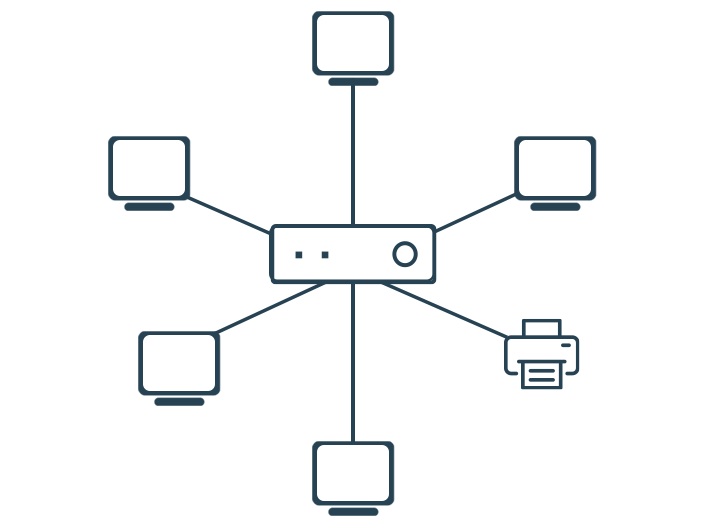
Definition: Star topology is a network configuration where all devices (nodes) are connected to a central hub or switch. Each node communicates through this central point, which manages data transmission across the network.
Characteristics
- Central Hub: All devices are connected to a single central hub or switch, which acts as a repeater for data signals.
- Point-to-Point Connections: Each node has its own dedicated connection to the hub, allowing for direct communication.
Advantages
- High Reliability: If one connection fails, it only affects that particular device, leaving the rest of the network operational.
- Easy Troubleshooting: Problems can be isolated to individual connections, making it simpler to identify and fix issues.
- Scalability: New devices can be easily added to the network without disrupting existing connections, facilitating growth.
Disadvantages
- Hub Dependency: The central hub represents a single point of failure; if it fails, the entire network becomes inoperable.
- Cost: More cabling and the cost of the hub or switch can make it more expensive than simpler topologies like bus topology.
- Limited Cable Length: The length of the connections to the hub can limit the overall size of the network.
Use Cases
- Business Networks: Commonly used in office environments where reliability and ease of management are critical.
- Home Networks: Frequently used in residential setups, especially with wireless routers acting as central hubs.
3- Ring Topology
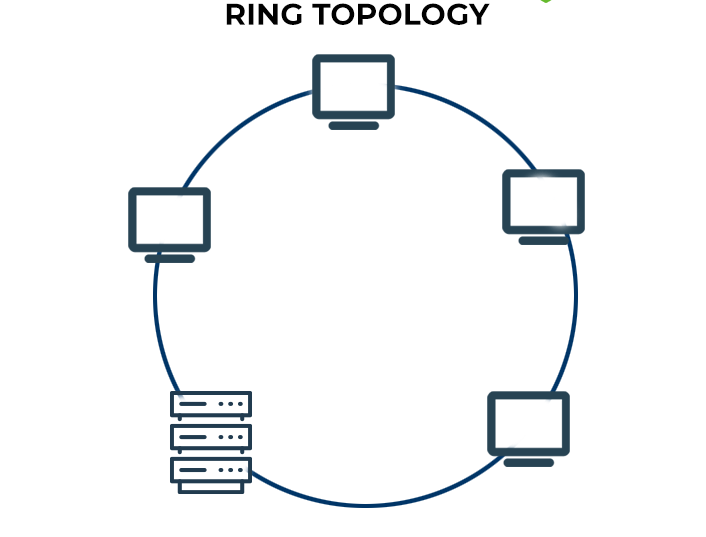
Definition: Ring topology is a network configuration where each device (node) is connected to two other devices, forming a closed loop. Data travels in one direction (or sometimes in both directions) around the ring, passing through each node until it reaches its intended destination.
Characteristics
- Circular Structure: Each node connects to two adjacent nodes, creating a continuous loop for data transmission.
- Token Passing: In some implementations, a token circulates around the ring. Only the device holding the token can send data, which helps manage network traffic.
Advantages
- Consistent Data Transmission: Data travels in a predictable path, leading to consistent and orderly transmission without collisions.
- Simple to Manage: The structure allows for straightforward management and monitoring of network performance, making it easier to identify faults.
- Less Data Collisions: The token-passing mechanism reduces the chances of data collisions, enhancing overall efficiency in data transmission.
Disadvantages
- Single Point of Failure: A failure in any node or connection can disrupt the entire network, as the data cannot complete its circuit.
- Difficult to Troubleshoot: Identifying the exact point of failure can be challenging since the entire network can be affected by a single issue.
- Limited Scalability: Adding or removing devices can be cumbersome and may require temporarily taking the network offline.
Use Cases
- Local Area Networks (LANs): Commonly used in small LANs where predictable data flow and easy management are advantageous.
- Telecommunications Networks: Utilized in some telecom systems where reliability is crucial, particularly for certain data routing applications.
4- Mesh Topology
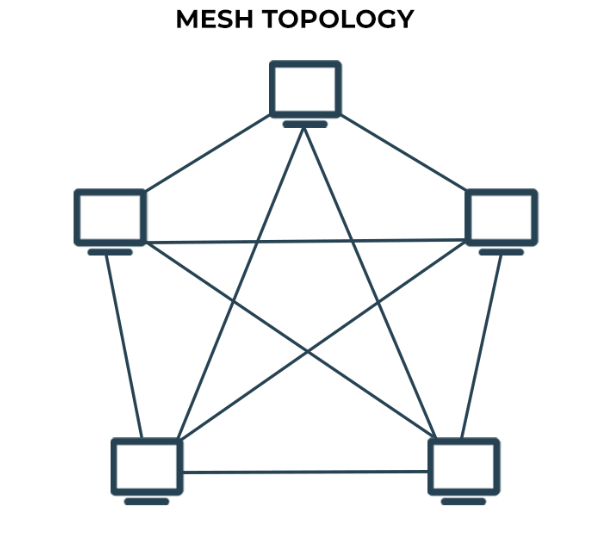
Definition: Mesh topology is a network configuration where each device (node) is interconnected with multiple other devices. This design creates a web of direct communication paths, ensuring that data can travel between nodes through multiple routes, enhancing redundancy and reliability.
Characteristics
- Full vs. Partial Mesh: In a full mesh topology, every node is connected to every other node, while in a partial mesh, some nodes are connected to multiple nodes but not all.
- Decentralized Structure: There is no central node; instead, data can travel via multiple pathways, reducing the risk of a single point of failure.
Advantages
- High Redundancy: Mesh topology provides multiple paths for data to reach its destination. If one path fails, data can reroute through another, ensuring uninterrupted communication.
- Improved Reliability: Due to its redundancy, mesh networks are highly reliable, making them suitable for critical applications where downtime must be minimized.
- Efficient Data Distribution: Mesh networks can balance traffic load across multiple paths, optimizing data distribution and reducing congestion.
Disadvantages
- Expensive Implementation: The cost of cabling and network interfaces can be high, particularly in a full mesh configuration, due to the large number of connections required.
- Complex Setup and Maintenance: Installing and maintaining a mesh network requires sophisticated planning and ongoing management, as the interconnected nature adds layers of complexity.
- Scalability Issues: Adding more nodes increases the complexity exponentially, making it challenging to scale large mesh networks.
Use Cases
- Military Networks: Used in tactical communication systems where reliability and redundancy are crucial for maintaining continuous operations.
- Data Centers: Mesh topology is employed in data centers for its resilience and ability to handle high traffic loads without bottlenecks.
- IoT Systems: Frequently used in Internet of Things (IoT) environments, where multiple devices need to communicate across a distributed network.
5- Tree Topology
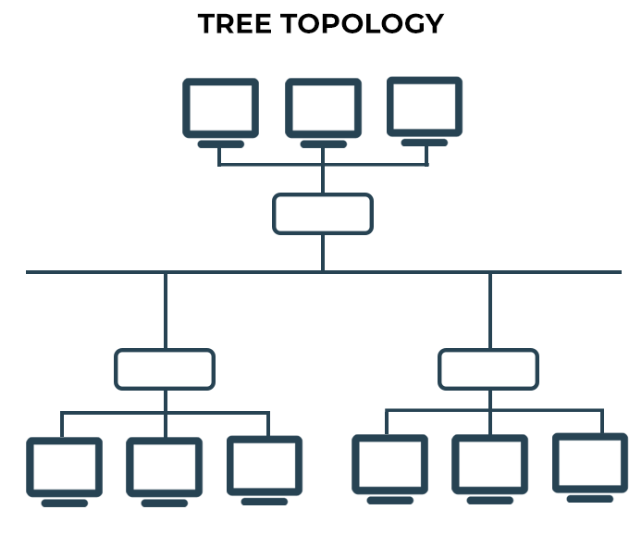
Definition: Tree topology is a hierarchical network structure that combines characteristics of both star and bus topologies. It features a central “root” node that acts as the backbone, with branches extending to various nodes. Each branch can further connect to additional nodes, creating a multi-level, tree-like structure.
Characteristics
- Hierarchical Design: The network is organized in levels, where each level represents a different category of devices or functions.
- Combination of Topologies: It incorporates features from both star and bus topologies, allowing for flexible design and management.
Advantages
- Scalability: New nodes can be easily added to the tree without disrupting existing connections, making it ideal for growing networks.
- Hierarchical Management: The tree structure allows for efficient management, where different branches can be managed separately according to their specific needs.
- Fault Isolation: Problems can be isolated within specific branches, making troubleshooting easier and less disruptive to the entire network.
Disadvantages
- Backbone Vulnerability: The failure of the central backbone (root node) can lead to a significant loss of connectivity across the network.
- Complex Setup: Implementing a tree topology can be more complicated than simpler topologies, requiring careful planning and configuration.
- Cost: While it may be less expensive than a full mesh, the overall cost can still be significant due to the cabling and devices required for a robust backbone.
Use Cases
- Large Organizations: Commonly used in enterprises where different departments or functions need to be organized hierarchically, allowing for specialized management.
- Educational Institutions: Often employed in schools and universities to connect various departments, classrooms, and administrative offices efficiently.
- Wide Area Networks (WANs): Useful in WAN setups where multiple locations need to connect back to a central office or data center.
6- Hybrid Topology
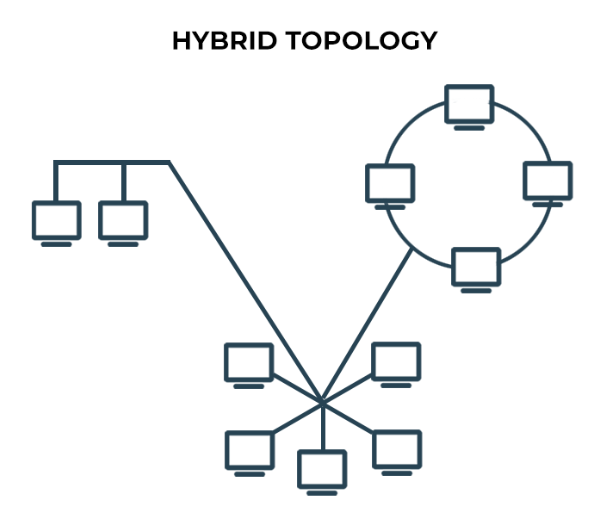
Definition: Hybrid topology is a network architecture that combines two or more different topologies, such as star, ring, bus, or mesh, to create a versatile and efficient network. This amalgamation allows organizations to leverage the strengths of various topologies while minimizing their weaknesses.
Characteristics
- Versatile Design: The configuration can be tailored to meet specific organizational needs, incorporating elements that best suit the intended application.
- Mixed Nodes: Different segments of the network can operate under different topologies, enabling a blend of performance characteristics.
Advantages
- Flexibility: Hybrid topology allows for customization, making it adaptable to diverse environments and requirements. Organizations can implement various topologies where they are most effective.
- Scalability: New nodes can be added easily without disrupting existing connections, enabling growth and adaptation to changing needs.
- Improved Performance: By optimizing the use of different topologies, hybrid networks can enhance performance, reliability, and fault tolerance.
Disadvantages
- Complex Management: The integration of different topologies can lead to increased complexity in network management and maintenance, requiring skilled personnel.
- Cost: Implementing a hybrid topology may involve higher costs due to the need for various networking devices and cabling types.
- Interoperability Issues: Ensuring seamless communication between different topological segments can present challenges, requiring careful planning and configuration.
Use Cases
- Large Enterprises: Often used in organizations with diverse needs, where different departments or functions may require unique networking solutions.
- Data Centers: Common in data center environments, where a mix of topologies can optimize performance and reliability for various applications.
- Telecommunications Networks: Employed in telecom infrastructures, combining multiple topologies to accommodate various services and technologies.
Why is Network Topology Important?
- Network Performance: The choice of topology directly affects data transmission speeds and overall network efficiency, influencing how quickly and reliably data travels between nodes.
- Scalability: Different topologies offer varying levels of scalability, allowing organizations to grow their networks seamlessly by adding new devices without significant disruption.
- Fault Tolerance: Certain topologies, such as mesh and hybrid, provide multiple pathways for data, enhancing redundancy and minimizing downtime in case of device or connection failures.
- Cost-Effectiveness: Understanding topology helps in optimizing cabling and device requirements, enabling cost-effective solutions tailored to specific networking needs.
- Management and Maintenance: The structure of the network impacts ease of management; some topologies allow for simpler troubleshooting and maintenance processes.
- Security Considerations: Topology influences the implementation of security measures, determining how effectively the network can be secured against unauthorized access and vulnerabilities.
- Data Flow Control: Different topologies manage data flow in unique ways, affecting how data packets are routed and the potential for collisions or bottlenecks.
- Flexibility: Certain topologies offer greater flexibility in network design, enabling organizations to tailor their infrastructure according to specific operational requirements.
Understanding various network topology types empowers organizations to build adaptable and scalable networks that meet their unique operational needs.
Conclusion
In conclusion, understanding network topology types is vital for designing efficient and reliable networks. Each topology presents distinct advantages and drawbacks, influencing performance, scalability, and fault tolerance. By carefully selecting the appropriate topology, organizations can optimize their infrastructure to meet specific needs while ensuring future growth and adaptability. As technology continues to evolve, the significance of choosing the right network topology types will only increase, making it essential for network architects and administrators to stay informed and strategic in their approach. Ultimately, the right topology can serve as the backbone of a robust, responsive network environment.
In the realm of networking, the selection of network topology types can mean the difference between a seamless connection and a tangled web of complications.
FAQs on Network Topology Types
- What are the main network topology types? The primary network topology types include star, ring, bus, mesh, tree, and hybrid topologies, each with unique characteristics and applications.
- How do I choose the right network topology type for my organization? Consider factors such as scalability, cost, reliability, and ease of management when selecting the appropriate network topology type for your needs.
- What is the difference between star and bus topology? Star topology connects all devices to a central hub, while bus topology connects devices along a single cable. Each has distinct advantages and disadvantages in terms of performance and fault tolerance.
- Can I combine different network topology types? Yes, hybrid topologies allow for the combination of various network topology types to create a flexible and efficient network tailored to specific requirements.
- What are the advantages of mesh topology? Mesh topology provides high redundancy and reliability, allowing data to reroute through multiple paths, making it ideal for critical applications.
- What are the limitations of ring topology? A key limitation of ring topology is its vulnerability; if one node or connection fails, it can disrupt the entire network.
- How does network topology affect performance? Different network topology types can impact data transmission speed, efficiency, and the potential for data collisions, influencing overall network performance.
- Is tree topology suitable for large organizations? Yes, tree topology is well-suited for large organizations as it supports hierarchical structures, making management and scalability more manageable.




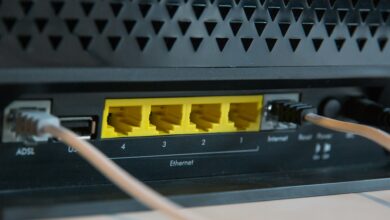
I don’t think the title of your article matches the content lol. Just kidding, mainly because I had some doubts after reading the article.